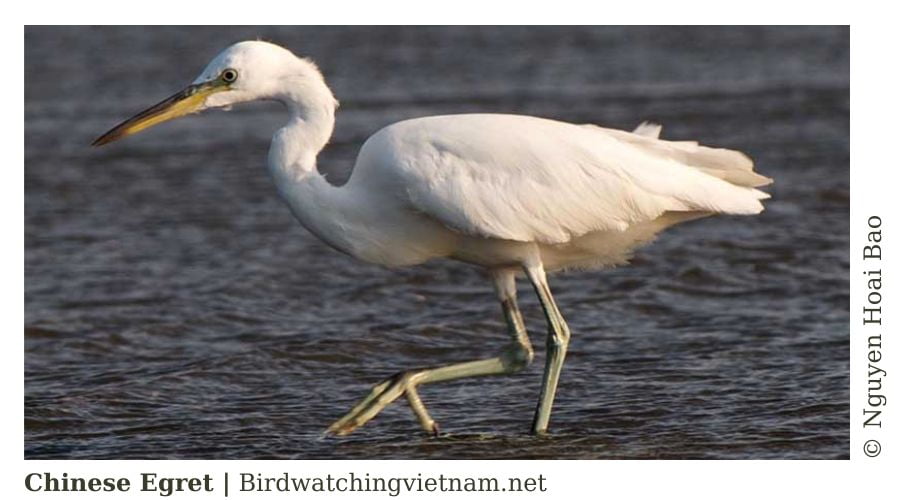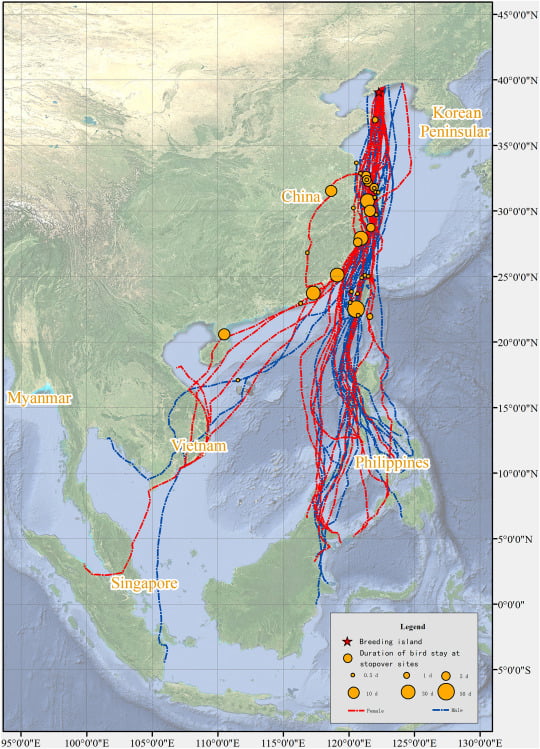[Science new: Migration and wintering of vulnerable adult Chinese Egrets (Egretta eulophotes) revealed by GPS tracking public on sciencedirect.com]
Abstract
Knowledge of migratory bird requirements is critical to developing conservation plans for vulnerable migratory species. This study aimed to determine the migration routes, wintering areas, habitat uses, and mortalities of adult Chinese Egrets (Egretta eulophotata).
Sixty adult Chinese Egrets (31 females and 29 males) on an uninhabited offshore breeding island in Dalian, China were tracked using GPS satellite transmitters. GPS locations recorded at 2 h intervals from June 2019 to August 2020 were used for analysis.

A total of 44 and 17 tracked adults completed their autumn and spring migrations, respectively. Compared with autumn migration, tracked adults displayed more diverse routes, higher number of stopover sites, slower migration speed, and longer migration duration in the spring. Results indicated that migrant birds had different behavioral strategies during the two migratory seasons. The spring migration duration and stopover duration for females were significantly longer than those for males.
A positive correlation existed between the spring arrival and spring departure dates, as well as between the spring arrival date and stopover duration. This finding indicated that the egrets that arrived early at the breeding grounds left the wintering areas early and had a shorter stopover duration. Adult birds preferred intertidal wetlands, woodlands, and aquaculture ponds during migration.
During the wintering period, adults preferred offshore islands, intertidal wetlands, and aquaculture ponds. Adult Chinese Egrets showed a relatively low survival rate compared with most other common ardeid species.
Dead specimens were found in aquaculture ponds, indicating human disturbance as the main cause of death of this vulnerable species. These results highlighted the importance of resolving conflicts between egrets and human-made aquaculture wetlands and protecting intertidal flats and offshore islands in natural wetlands through international cooperation.
Our results contributed to the hitherto unknown annual spatiotemporal migration patterns of adult Chinese Egrets, thereby providing an important basis for the conservation of this vulnerable species.

Source: Avian Research Volume 13, 2022, 100055
READ FULL this paper HERE
Dalat Plateau Birding Herping and Wildlife Tours
The Dalat Plateau, rising 2,000 meters above sea level, is one of Vietnam’s most important [...]
Cat Tien National Park Birding Herping and Wildlife Tours
Cat Tien National Park tours offer an unforgettable experience with sightings of Germain’s Peacock Pheasant, [...]
Western Black Crested Gibbon – Nomascus concolor
Nestled within the verdant landscapes of Vietnam, the Western Black Crested Gibbon (Nomascus concolor) emerges [...]
Northern White-cheeked Gibbon – Nomascus leucogenys
The northern white-cheeked gibbon (Nomascus leucogenys) is a Critically Endangered gibbon species indigenous to South [...]
Northern Yellow-cheeked Crested Gibbon – Nomascus annamensis
The Northern Yellow-Cheeked Crested Gibbon, or Nomascus annamensis, is an exclusive primate species found in [...]
Eastern Black Crested Gibbon – “Cao-vit Gibbon” – Nomascus nasutus
Nestled within the dense, emerald-green forests of Vietnam, the Eastern Black Crested Gibbon (Nomascus nasutus), [...]